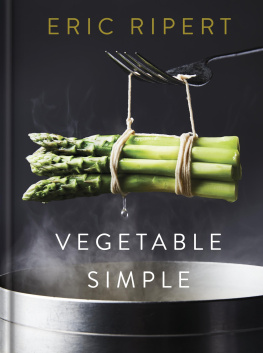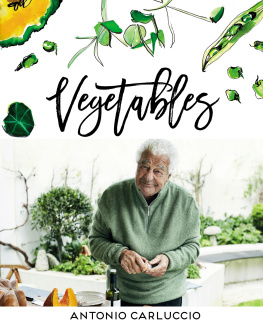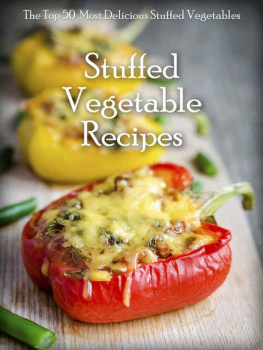Contents
Landmarks
Print Page List
ACKNOWLEDGMENTS
Vegetable Simple was a long time in the making, from when I first conceived the idea to now, writing this note of gratitude. It became a very personal endeavor, and my passion for the book only increased throughout the process, and I am so glad to be able to finally share it with all of you. The reality of Vegetable Simple was only made possible by my close community of family, friends, and colleagues who believed in it and supported me over the few years it took to achieve.
Kim Witherspoon, my agent, champion, ally, but most important, my friend, who always strives for the best for me. Andy Ward for his trust and confidence in me as well as the entire Random House team for bringing this book to life. I would like to express a special appreciation to Susan Kamil, who sadly passed as I sat down to write this. Her support over the years meant so much and I, like many others, was blessed to have her in my corner.
My dear friend Nigel Parry, who took a chance, humored my crazy idea, and agreed to shoot this book. He captured these vegetables with the same passion and artistry as he does his portrait subjects.
My Le Bernardin family, to whom Im indebted for their constant support and hard work and for allowing me the time needed to create this book. Special thanks to chef Erik Fricker with help from Tim Alvarez, and to our pastry chef Thomas Raquel, who worked tirelessly on the recipes, and to Laurie Woolever for testing, adapting, and formatting them. It took time and patience, for which Im grateful.
Cathy Sheary, my professional guardian angel, who also collaborated with me in the writing process and persevered in project-managing the book from the beginning. Thanks also to Remy Albert for all her help at the final hurdles.
My wife, Sandra, and son, Adrien, for their unconditional love and support, and for being my biggest and best defenders. I love you both more every day.
To Maguy Le Coze for her unwavering friendship, encouragement, and belief in me.
Lastly, I would like to thank Matthieu Ricard, who, through his book A Plea for the Animals, planted the seed that ultimately led me to create Vegetable Simple .
BY ERIC RIPERT
Vegetable Simple
32 Yolks
My Best
Avec Eric
A Return to Cooking
On the Line
Le Bernardin: Four-Star Simplicity
TIPS & GUIDELINES
A condensed guide to buying, storing, and making the most out of vegetables
1. SEASONS
There are reasons for the seasons! Fruits and vegetables purchased in their season will look, feel, smell, and taste their very best compared with those purchased out of season, even if only by a few weeks. For example, tomatoes are at their peak in summer because they require a lot of sunlight as well as a warm climate. Even when grown in the best artificial conditions, they wont be nearly as good as they are in the summer months. I encourage you to shop at farmers markets whenever you can, as they are the best indication of whats in season.
2. ORGANIC
If you have the means and access, I recommend buying organic when possible. While organic produce is a little more expensive, its a positive commitment to your health as well as the health of the environment. Organic fruits and vegetables are non-GMO and have not been treated with harmful pesticides or fertilizers that are potentially damaging to our land and waters. Buying organic doesnt necessarily guarantee the products will taste better, but the odds are higher that they will.
3. LOCAL
There are many benefits to buying local, whether directly from farmers or in stores that advocate for small food producers in the area. Supporting local growers is not only a great way to connect with farmers and artisans but supports the local economy, champions good food practices, and helps preserve land from large developments.
4. SHOPPING WITH YOUR SENSES
The trick to choosing the best produce at the market or grocery store is actually by taking a very logical approach to shopping. Once you pick a fruit or vegetable thats in season, use your senses to help you figure out which one is best. Your eyes give you a lot of information; you can see any damage, bruising, discoloration, and mold, as well as some signs of dryness or ripeness. Touching the item supports what you see; for instance, an avocado shouldnt be hard as a rock or too soft to the touch. And then theres your sense of smell, which is more instinctive. Good mushrooms have a very strong, fresh earthy smell; melons are sweet and slightly floral; and fennel is very aromaticbright, sweet with strong hints of anise. These smells will stay with you, and the more you incorporate using your nose, the more you will develop your knowledge of what good produce smells like. Using your senses and your gut instincts, as well as the knowledge of whats in season, will result in a successful shopping trip.
5. TIMING / PLANNING + BUYING ONLY WHAT YOU NEED
Its important not to buy your produce too far in advance of when you plan to cook it, especially if you are close to the source. Once harvested, fruits and vegetables can be very sensitive to their new environment. Factors such as inadequate light, temperature, and storage conditions can speed up the deterioration process, so knowing when to buy will help reduce food waste. For example, greens and leafy salads lose their quality very quickly; however, a root vegetable can last much longer in the refrigerator before it starts to deteriorate. Meal planning is the key to not overpurchasing. I recommend shopping for fresh fruits and vegetables no longer than 48 hours in advance to avoid potential spoilage and to ensure you cook and eat your produce while it is still at its best. This practice saves money, lessens waste, and also limits the possibility of a repetitive diet.
6. STORAGE
Food storage can sometimes be an afterthought, but knowing some general rules of thumb will improve the shelf life of both your fresh and dried goods. Overall, root vegetables can be stored in a cool environment for a relatively long period of time. More sensitive vegetables, such as leafy greens and mushrooms, have a much shorter lifespan and can only be kept refrigerated for short periods of time. Produce such as melons and tomatoes actually lose their flavor if kept chilled, so are better off in a moderately temperate area of your kitchen or pantry. When storing fruits or vegetables, either in the refrigerator or in a dedicated area or cupboard in your kitchen, its important not to stack them on top of each other, as some are more fragile than others. Aromatic foods should always be kept separate to avoid absorption by other foodsfor example, garlic or an onion if its been halved or peeled. Pastas, legumes (such as lentils and beans), and grains should be stored in airtight containers in a dark and dry place.
7. WASHING + CLEANING
More often than not, produce in the grocery store or market has been touched by many hands and its almost always the case that fruits, vegetables, and fresh herbs have some residual dirt, soil, dusts, and sometimes insects from when they were harvested. Cleaning your produce before cooking helps avoid cross-contamination, removes impurities, as well as eliminates any nasty tastes and textures. When washing salad, pat dry with paper towels to remove excess water. Sometimes I find that water isnt enough, so I add a few drops of white vinegar when Im cleaning fresh produce.
8. FREEZING
The main benefit of frozen food is that it can be kept for very long periods of time. I have found, with some exceptions, that its almost always better to buy great-quality frozen vegetables than mediocre fresh equivalents. Vegetables destined to be frozen are harvested at their peak, and with the advances in technology and food preservation, its very often the case that their nutrients are also preserved. Not every frozen vegetable is a good substitute for fresh, though, and nothing beats great-quality fresh produce.










